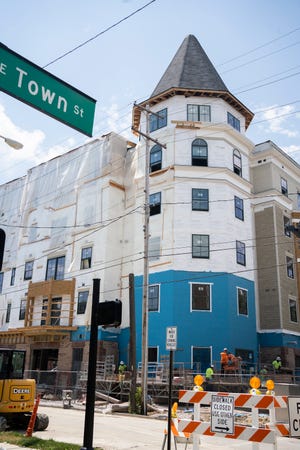Central Ohio’s poorest residents could live 5½ years longer if the region significantly boosts its housing stock, according to a new study that seeks to measure the peripheral damage of high housing costs.
The study, released Tuesday by the Affordable Housing Alliance of Central Ohio, concludes that 83,000 central Ohio households spend more than half their income on housing, well above the 30% threshold of what is considered affordable.
More:Affordable housing biggest challenge to central Ohio economy, execs say
In Franklin County, 52,000 households spend more than half their income on housing, a slight improvement over the 54,000 estimated in a 2017 Affordable Housing Alliance study.
Unlike previous affordable housing studies, this one seeks to also measure the residual costs. The study concludes that if the affordable housing “gap” is cut in half — to 41,500 households instead of 83,000 — the region’s quality of life would benefit in multiple ways because residents could devote more attention and resources to other parts of their lives.
“What’s really really exciting about this report, it’s the first time we’ve looked at not just the problem of housing but the whole litany of benefits if we can fix it — how it can make education better, health care better, and how can it benefit the economy overall,” said Carlie Boos, executive director of the Affordable Housing Alliance.
Relying on other studies, the alliance concludes that cutting the affordable housing gap in half would, for example:
- add 5½ years to life expectancy for the poorest Columbus-area residents, based on studies that link housing stability and income to life expectancy
- lead to 12 fewer infant deaths each year in central Ohio, based on an Ohio study that found that mothers in stable housing were about 25% more likely to have full-term babies
- add 40,000 construction and other jobs each year in the region if the number of new homes is doubled
- help 600 more students graduate from central Ohio high schools, based on studies linking graduation rates to housing stability
- lift 5,500 central Ohio children from poverty, based on money diverted from housing costs to other needs
“I think all 12 intersections we studied saw positive yardage, every single one saw gain, but a few stand out,” Boos said. “The first, if affordable housing need was cut in half, was that some citizens would extend life expectancy for five years. That’s five more Thanksgivings, five more birthdays, five more years with grandkids.”
The report is the latest of a string of warnings that the Columbus area is not building enough housing to keep up with demand, pushing housing prices out of reach of some residents. The city of Columbus has taken some steps toward remedying the problem by issuing $200 million in bonds to build more affordable housing and by revamping its zoning code to encourage more dense housing construction.
The report also recommends several steps to help reduce the affordable housing gap, including:
- Increasing access to low-cost loans for affordable housing development
- Expanding grants for affordable housing creation and preservation
- Launching an eviction prevention system
- Adopting protections to reduce income discrimination
- Creating more homebuyer assistance programs
- Protecting homeownership through taxation changes and home-repair assistance
Boos said the report did not estimate the cost of such steps, but noted that not all of them require money.
“Not everything on there has a monetary cost on it, such as low-cost loans — they get repaid,” she said. “And if we talk about reforming our zoning laws to reflect today’s reality and not 30, 50, 70 years ago, that has no cost to it.”
More:As Columbus booms, its suburbs limit affordable housing options
Boos and others say the report illustrates the peril of doing nothing.
“Central Ohio stands at a pivotal crossroads,” Affordable Housing Alliance Chair Bob Bitzenhofer said in a news release. “The region is facing a sizable affordable housing challenge — one that resonates throughout our society. Prioritizing affordable housing cannot only ease the burden on Ohio’s residents, but also unlock substantial community progress. This is a call to action.”
@JimWeiker
Read the full article here














